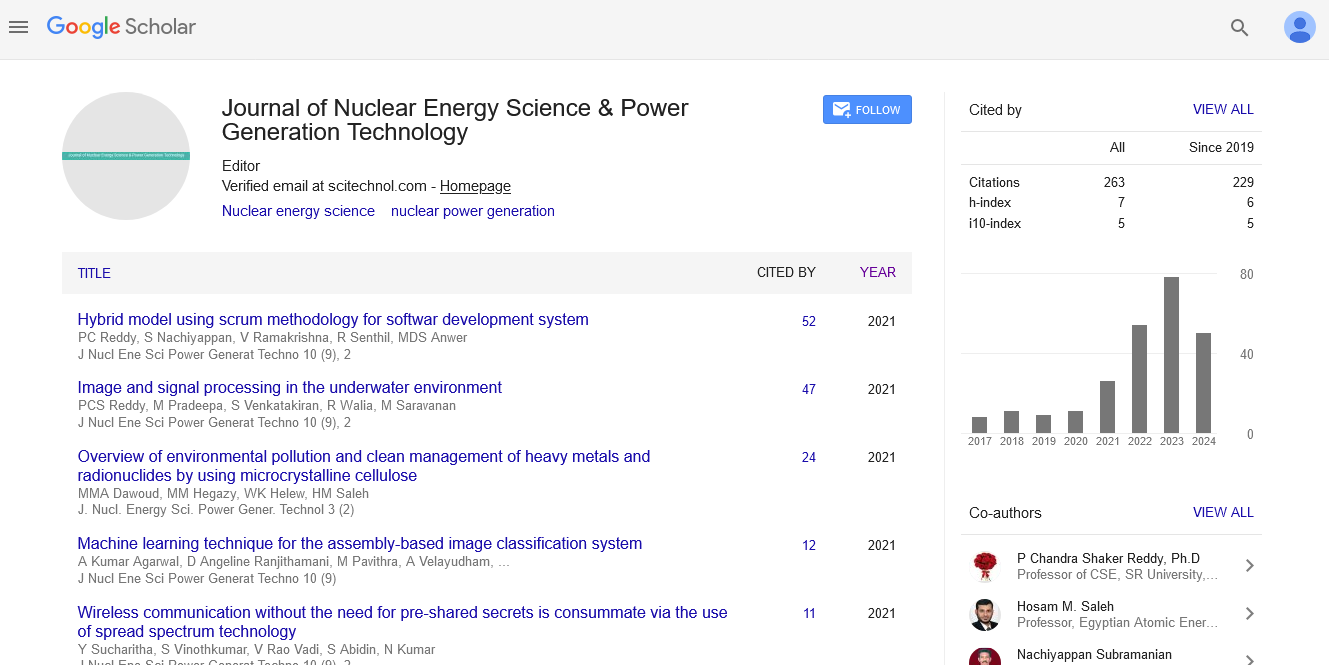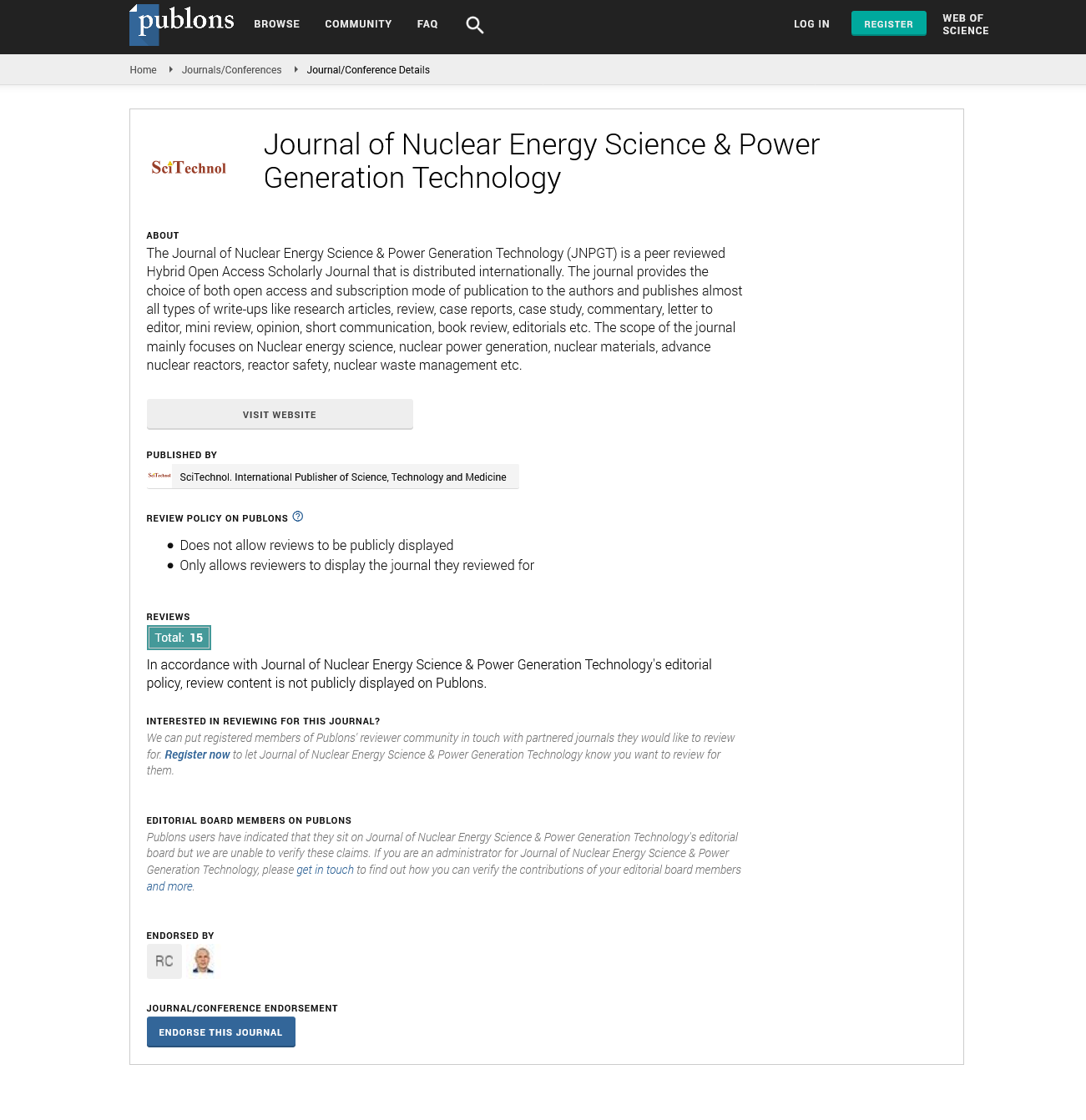Commentary, J Nucl Ene Sci Power Generat Technol Vol: 13 Issue: 4
Advancements in PUREX Process: Enhancing Efficiency and Reducing Environmental Impact
Hyeri Klen*
1Department of Materials Science and Engineering, Missouri University of Science and Technology, Rolla, USA
*Corresponding Author: Hyeri Klen,
Department of Materials Science and
Engineering, Missouri University of Science and Technology, Missouri, USA
E-mail: hyeri_klen789@gmail.com
Received date: 17 June, 2024, Manuscript No. JNPGT-24-143335;
Editor assigned date: 19 June, 2024, PreQC No. JNPGT-24-143335 (PQ);
Reviewed date: 03 July, 2024, QC No. JNPGT-24-143335;
Revised date: 11 July, 2024, Manuscript No. JNPGT-24-143335 (R);
Published date: 18 July, 2024, DOI: 10.4172/2325-9809.1000404.
Citation: Klen H (2024) Advancements in PUREX Process: Enhancing Efficiency and Reducing Environmental Impact. J Nucl Ene Sci Power Generat Technol 13:4.
Description
Fuel reprocessing is a vital component of the nuclear fuel cycle, aimed at recycling used nuclear fuel to extract valuable materials and reduce waste. This provides an in-depth look at the process of fuel reprocessing, its benefits, challenges, and its role in the future of nuclear energy. Fuel reprocessing involves chemically treating spent nuclear fuel to separate reusable fissile materials like uranium and plutonium from waste products. The process allows these materials to be reused in new fuel assemblies, thereby extending the life of nuclear fuel and reducing the volume of high-level radioactive waste. As global energy demands rise and the push for low-carbon energy sources intensifies, nuclear power remains a vital option. However, the sustainability of nuclear power is challenged by the management of spent fuel. Without reprocessing, used nuclear fuel accumulates, posing storage and environmental challenges. By extracting usable materials, the volume of high-level radioactive waste requiring longterm storage is significantly reduced. Reprocessed fuel can be reused, decreasing the need for mining and enriching new uranium. By recycling fuel, countries can reduce their dependence on imported uranium.
Fuel reprocessing involves several steps, primarily based on the Plutonium Uranium Redox Extraction (PUREX) method, which has been the standard since its development in the mid-20th century. Spent fuel assemblies are mechanically chopped into small pieces and dissolved in nitric acid to create a liquid solution. The solution undergoes solvent extraction, where chemicals separate uranium and plutonium from fission products and other transuranic elements. Separated uranium and plutonium are further purified to remove residual impurities. Purified uranium and plutonium are converted into suitable chemical forms and fabricated into new fuel assemblies for reactors. Combines plutonium with depleted uranium, suitable for use in light water reactors.
Reprocessed uranium can be re-enriched and fabricated into new fuel assemblies. Advanced reactors, such as fast breeder reactors, can use reprocessed plutonium and uranium to breed more fuel. Maximizes the use of extracted uranium and plutonium, reducing the need for fresh uranium mining. Reduces the volume and toxicity of high-level waste, simplifying storage and disposal. Enhances the overall efficiency of the nuclear fuel cycle by utilizing the energy potential of spent fuel. The cost of reprocessing can be high, and market conditions for uranium and plutonium can affect its economic feasibility. Reprocessing separates plutonium, which can be a proliferation concern if not adequately safeguarded. The reprocessing process is technically complex and requires advanced facilities and stringent regulatory controls. While reprocessing reduces waste volume, it still generates radioactive waste and chemical effluents that must be managed.
Conclusion
As the world moves towards sustainable energy solutions, fuel reprocessing is composed to play an essential role. Advances in reprocessing technology, such as pyro processing and proliferationresistant methods, are being developed to address current challenges. Integrating reprocessing with advanced reactor designs could lead to a more sustainable and efficient nuclear fuel cycle. Fuel reprocessing provides a pathway to sustainable nuclear energy by recycling valuable materials and reducing waste. While challenges remain, continued innovation and international cooperation can enhance the viability and safety of reprocessing, making it a source of future nuclear energy strategies.
 Spanish
Spanish  Chinese
Chinese  Russian
Russian  German
German  French
French  Japanese
Japanese  Portuguese
Portuguese  Hindi
Hindi 

